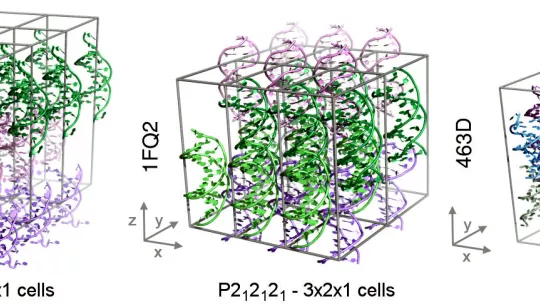Images
The breakthrough made by researchers at IRB Barcelona allows the study of the role of each molecular component in the stability and conformation of DNA crystals.
The new molecular simulation techniques are expected to reduce the time and cost of obtaining crystals in the laboratory.
Since the birth of structural biology, x-ray crystallography has been the most widely used technique to determine the three-dimensional structure of biomolecules—the chemical compounds found in living organisms. In this regard, knowledge of the interactions between the biomolecules with their crystal environment and the molecular forces that stabilize the crystals would serve to optimise this technique.
A study published in the journal Chem—produced by the Cell group—and undertaken by researchers at the Institute for Research in Biomedicine (IRB Barcelona) has been the first to achieve stable simulations of DNA crystals. This accomplishment has allowed the scientists to explain the importance of the chemical additives used experimentally to achieve suitable crystallization conditions and stable crystals in the laboratory.
“The first to benefit from this study is the community of biophysicists and computational physicists/chemists, who now have a reference and clear protocols through which to achieve stable simulations of DNA crystals,” says Pablo D. Dans, postdoctoral researcher at IRB Barcelona.
Led by Modesto Orozco, head of the Molecular Modelling and Bioinformatics lab, the study presents the most detailed atomic description of the properties of DNA crystals to date.
“In the long term, the simulation of several crystals obtained in a range of experimenal conditions should allow us to anticipate and predict the effect of a given chemical additive, thus serving to guide crystallographers in their experiments and considerably reducing the cost and time needed to obtain the crystals,” remarks Modesto Orozco, professor at the Faculty of Chemistry of the University of Barcelona, whose lab is an international reference in bimolecular computation and simulation.
The study has been supported by funding from the European Research Council (ERC), through an ERC Advanced Grant (SimDNA) awarded to Modesto Orozco, and from the European Consortium of Supercomputing Centres, through a grant provided in the 12th PRACE Call and awarded to the three authors of the study.
Artículo de referencia:
Antonija Kuzmanic, Pablo D. Dans and Modesto Orozco.
An in-depth look at DNA crystals through the prism of molecular dynamics simulations
Chem (2019) DOI: 10.1016/j.chempr.2018.12.007
About IRB Barcelona
The Institute for Research in Biomedicine (IRB Barcelona) pursues a society free of disease. To this end, it conducts multidisciplinary research of excellence to cure cancer and other diseases linked to ageing. It establishes technology transfer agreements with the pharmaceutical industry and major hospitals to bring research results closer to society, and organises a range of science outreach activities to engage the public in an open dialogue. IRB Barcelona is an international centre that hosts 400 researchers and more than 30 nationalities. Recognised as a Severo Ochoa Centre of Excellence since 2011, IRB Barcelona is a CERCA centre and member of the Barcelona Institute of Science and Technology (BIST).








